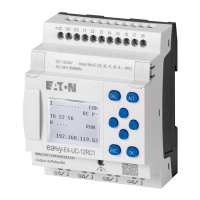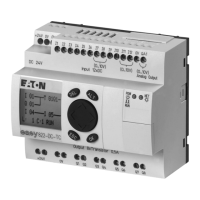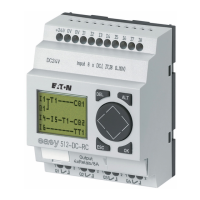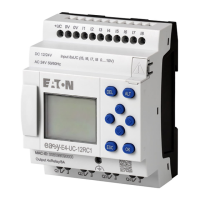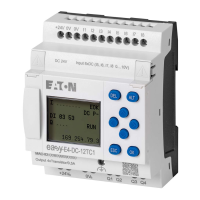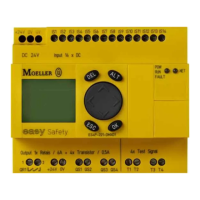4 Wiring with
4.15 Circuit examples
Operating instructions 05/10 MN05013003Z-EN www.eaton.com 157
Assign the information “bad” to value 0. Should the shift register be
accidentally deleted, no bad parts will be reused.
• I1: Shift pulse (PULSE)
• I2: Information (good/bad) to be shifted (VALUE)
• I3: Clear content of the shift register (RESET)
• M1: 1st storage location
• M2: 2nd storage location
• M3: 3rd storage location
• M4: 4th storage location
• M7: Marker relay for cycle pulse
• M8: Cyclical pulse for shift pulse
Figure 86: easy circuit diagram shift register
4.15.2.1 How does the shift register work?
The shift pulse is activated for exactly one cycle. To do this, the shift pulse is
generated by evaluating the change from I1 OFF to I1 ON – the rising edge.
In this way, therefore, the cyclical processing of easy is used to trigger the
shift pulse.
When I1 is activated for the first time, the marker relay N/C contact M7 is
closed during the first pass through the cycle. Thus, the series connection
consisting of I1, N/C contact M7 (closed) and M8 is activated. Although M7 is
now also activated, this does not yet have any effect on contact M7.
The contact of M8 (N/O contact) was still open during the first cycle so a shift
pulse cannot yet be generated. When the relay coil is activated, easy
transfers the result to the contacts.
In the second cycle N/C contact M7 is open. The series connection is
opened. The contact M8 is activated from the result of the first cycle. Now,
all the storage locations are either set or reset in accordance with the series
connection.
Generate shift pulse
4th memory position, set
4th memory position, delete
3rd memory position, set
3rd memory position, delete
2nd memory position, set
2nd memory position, delete
1st memory position, set
1st memory position, delete
Delete all memory positions
I1uM7----ÄM8
h------ÄM7
M8uM3----SM4
dM3----RM4
dM2----SM3
dM2----RM3
dM1----SM2
dM1----RM2
dI2----SM1
hI2----RM1
I3------uRM1
dRM2
dRM3
hRM4
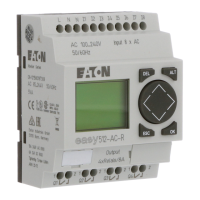
